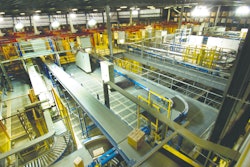New York — December 14, 2010 — Supply chain efficiencies remain a primary focus for industrial space users nationwide heading into the final weeks of 2010. And as movement begins to pick up among tenants, especially in the country's major intermodal markets, we will end the year optimistic regarding fourth-quarter performance and a positive outlook heading into 2011.
Vacancy rates appear to have stabilized, and we do not see anything on the horizon that will alter this welcome news. The overall vacancy rate for the US industrial market remained at 10.6 percent at the end of the third quarter of 2010, unchanged from midyear, after peaking at 10.8 percent at the end of the first quarter.
In fact, half of the 34 industrial markets Cushman & Wakefield tracks registered a quarter-over-quarter decrease in vacancy rates. Among them, Boston saw a 1.4 percentage point decrease, to 18.8 percent; Portland, Ore., recorded a 1.3 percentage point decrease, to 7.3 percent; and Contra Costa, Calif., had a 0.7 percentage point decrease, to 14.0 percent.
Leasing totals reached 189.8 million square feet through the first nine months of 2010, an 11.9 percent increase from the 169.5 million square feet leased during the same period in 2009. Twenty US industrial markets charted a year-over-year leasing increase.
More, But Smaller
Much of this activity revolves around companies' drive toward increased supply chain efficiencies. In one notable trend, we are seeing a shift toward companies taking more, but smaller, distribution buildings closer to their consumer bases. This is especially prevalent among big-box retail.
We also are seeing more companies being drawn to major intermodal markets. These multi-faceted transportation hubs can be a key part of improving logistics because they enable tenants to use multiple means — rail, truck, air and water — to move goods.
As such, first-tier intermodal markets like Chicago, Memphis, Dallas and Harrisburg, Pa.; and even second-tier markets like Kansas City, Mo., likely will see healthy growth in 2011 and beyond. Rail hubs will remain integral to the industrial sector as well, providing one of the most consistent and reliable transportation modes in the face of unpredictable fuel and freight pricing, and ever-increasing road congestion.
Chipping away at Inventory
Regardless of how corporations are executing their supply chain strategies, the end result is that they again are doing something with their industrial real estate. This movement already is beginning to chip away at available inventory nationwide. Absorption is improving notably. At negative 6.2 million square feet through the third quarter of 2010, this number is significantly better than the negative 118.5 million square feet recorded at the end of the third quarter of 2009.
This year is on track to see the most limited amount of new construction added to the United States industrial inventory since Cushman & Wakefield began tracking the market. We expect that the lack of new product (12.3 million square feet of completions through the third quarter of this year, as compared to 136 million square feet completed during 2008) will push this absorption into the black by as early as mid-2011. This will alleviate the prolonged downward pressure on rents that we have experienced during the past two years.
This all is encouraging news going into 2011. At this time next year, we hope to be reporting a truly healthy picture illustrated by a continued check on new construction, lower vacancies, positive absorption and healthy rent increases. Until then, we look forward to watching the beginnings of the turnaround grow into tangible, positive near-term progress.
Related Stories
- The Art of Supply Chain Optimization — A logistics team is called upon to craft supply chain processes that update logistics and inventory management at the growing retail chain Michaels Stores Inc.
- Keeping Supply Chain Transformation Simple — Stryker Instruments achieved success in inventory optimization by taking a no-frills approach and relying on collaborative supplier relations
- The Last Mile is the Longest Mile — Best practices for optimizing last mile pick up and delivery operations
- Optimization is a Four-letter Word — Got warehouses? Got manual processes? Read the case for thoughtful automation in the fulfillment center


![Pros To Know 2026 [color]](https://img.sdcexec.com/mindful/acbm/workspaces/default/uploads/2025/08/prostoknow-2026-color.mduFvhpgMk.png?auto=format%2Ccompress&bg=fff&fill-color=fff&fit=fill&h=100&q=70&w=100)




